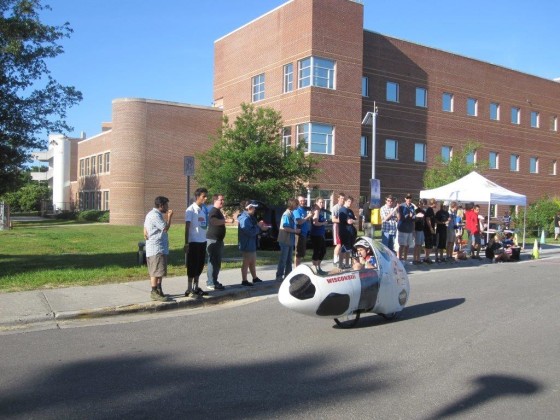In today’s world of ever-evolving automotive and mechanical technology, changes happen fast and often. Today’s colleges and universities prepare future engineers for these challenges through hands-on training with teams such as Human Powered Vehicles, Solar Cars, Formula SAE cars and more.
A great example of this is the University of Wisconsin-Madison Human Powered Vehicle team. Students are tasked with designing and building a vehicle that is a green alternative to automobiles, and can compete against approximately 35 other teams at the ASME East Coast HPVC. These vehicles are created with professional engineering software, tested in wind tunnels and on race tracks, and provide extremely valuable experience for the engineers of tomorrow.

Although the HPVC is generally quite competitive, cooperation among rival teams still happens. In this case the University of Wisconsin-Madison received a Precision Board Plus donation from none other than the Missouri S & T HPV team. This donation would enable the students to build master molds to create a carbon fiber body for their car – an improvement that would save weight and provide valuable hands-on experience with carbon fiber for students.
The main goals for the 2014 UW-Madison Human Powered Vehicle were to make it as fast and lightweight as possible, in order to perform well at the competition drag race and still function as a practical, reliable vehicle for everyday commuting.
According to team leader Alex Ebertowski, “The donated Precision Board Plus allowed us to take a huge step forward in our mold making process. With the aid of Precision Board, we were able to mold fiberglass female molds for the carbon fiber layup, which we did in sections that allowed to get an extremely smooth outside finish and custom layering and core material placement. This allowed us to strictly regulate the amount of epoxy we used – with the end result being a vehicle 20 lbs. lighter than the one we made in 2013.”
UW-Madison team members CNC machined ten separate molds from Precision Board, which then had fiberglass layed up onto them to form ten female molds. These female molds were then bolted together to form a front and back half and other parts for the vehicle.


After the fiberglass molds were bolted together, the carbon fiber body halves were produced via a vacuum bagging procedure. After removal, they were trimmed, aligned and attached together with carbon fiber tape.

Team Member Sean Bocher also shared his thoughts on how the new tooling experience benefitted the University of Wisconsin: “Having tooling board this year was a huge benefit. We were able to bond sheets together easily, and a local company was able to CNC all of our molds – a huge time saver compared to last year. Also, the polystyrene last year was very difficult to sand, but the Precision Board was a breeze!”

Since Wisconsin is known as the dairy state, team members christened the 2014 HPV “Udder Domination,” and went with a cow-themed paint scheme (the black spots are exposed carbon fiber with clear coat).
Udder Domination made its debut at the ASME-sponsored Human Powered Vehicle Competition, held this year at the University of Central Florida in Orlando. “Udder Domination competed against 35 other schools at the HPVC East competition. Despite our 2014 vehicle being over 20 lbs. lighter than the previous years vehicle, we were unable to use it to the fullest of its capabilities, as numerous technical malfunctions plagued us during the tournament. On the other hand, it is still the best vehicle we have ever built and that experience will be asset when it comes to designing and building the 2015 HPV,” states Ebertowski.
 UW-Madison HPV team members Emily Wunsch, Alex Ebertowski, Drew Motl, Austin Cruz, Sean Bocher, Gustave Granroth, Lucas Benish and Paige Kiecker.
UW-Madison HPV team members Emily Wunsch, Alex Ebertowski, Drew Motl, Austin Cruz, Sean Bocher, Gustave Granroth, Lucas Benish and Paige Kiecker.
Next year, University of Wisconsin – Madison HPV members will be constructing a new vehicle and plan to further increase the mechanical advancements they have made to build a lighter, faster vehicle. Be sure to see more information about them on their blog!
A competition recap can also be seen here.
 UW-Madison HPV members pose next to competitors/friends from the Missouri S & T HPV team.
UW-Madison HPV members pose next to competitors/friends from the Missouri S & T HPV team.